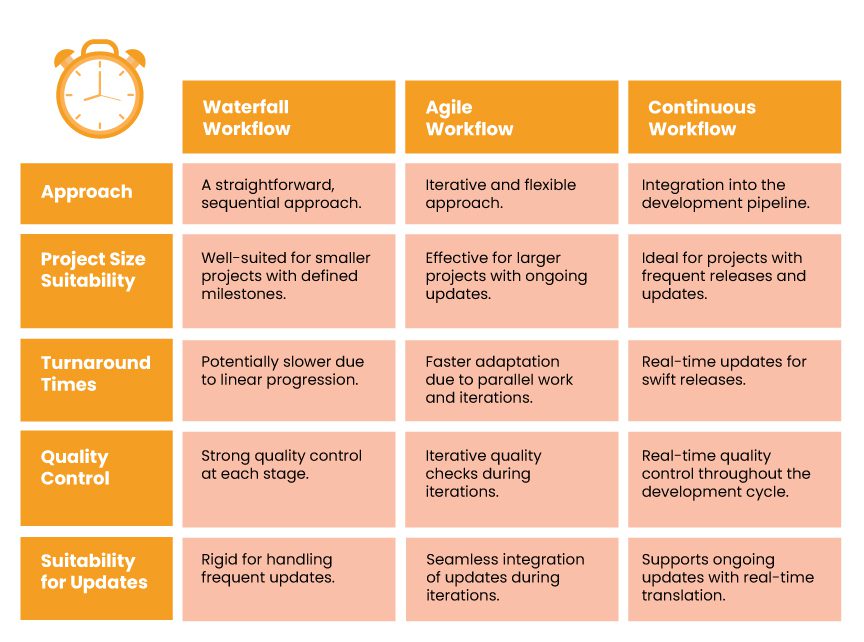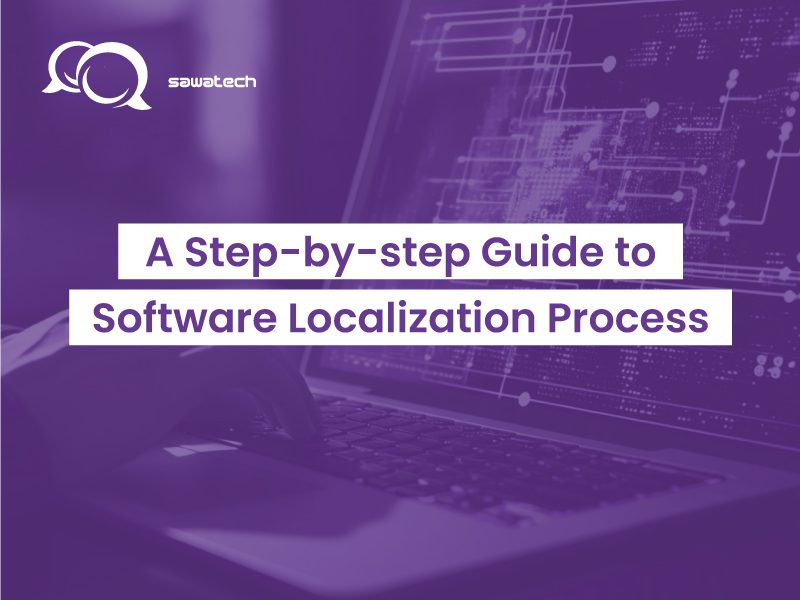Software is basically everywhere around us. Although it’s universal and is part of virtually all modern products and services, in most cases it doesn’t speak the language of its users.
Software localization comes as a strategic advantage for businesses to expand and adapt their software to different languages and cultures.
But, here’s the catch: without a strong focus on quality, all those efforts might just fall apart like dominoes.
The software localization process is sophisticated and multi-layered and it’s easy for translation mistakes and technical glitches to slip through the cracks of poor planning and execution.
If you are planning for software localization, this is the only guide that you’ll ever need to inform your journey. Learn about software localization and its intricate process From laying the groundwork to putting the finishing touches.
What Is Software Localization?
While software localization is commonly linked with translation, it encompasses a more comprehensive process that goes beyond mere word-to-word conversion.
Software localization entails meticulous adaptations in language, design, and functionality to resonate with the target market’s cultural nuances and specific language requirements.
And the goal is simply to make the software appear as if it were specifically designed for your target audience, ensuring accessibility to your products or services and improving the user experience.
So, it isn’t something that can be completed solely by translators. You require the assistance of linguistic experts, software developers, testers, cultural consultants, and quality assurance specialists to ensure a seamless software localization process.
But before we break down the software localization process, how software localization can empower your business’s global expansion?
3 Reasons Why You Need Software Localization
1. Better User Experience
Language stands as a key component of user experience.
Consider this scenario of a user in a new market opening a new app or using your website for the first time. The language it speaks shapes the very first impression a user forms when interacting with it.
It determines the accessibility, usability, and appeal of your website or app to your new audiences.
Now, 42% of users never buy products or services in languages other than their native tongue. And that’s a survey among internet users in 23 European countries only – a continent with the highest English language proficiency.
This percentage could possibly be doubled or tripled in lower proficiency countries/regions.
With a focus on your software’s language accessibility, UI, and functionality, software localization enhances your user experience. They can easily navigate and interact with your website, app, or device in their native language, making them more likely to engage with and be loyal to your product.
2. Local Competitive Advantage
We know it’s challenging to compete in a local market with many competitors already. For one thing, they speak the language of their customers. But there’s more. They have built long-standing relationships with their customer base over the years and have an unparalleled understanding of the local market dynamic and local regulations.
The thing is you aren’t only competing on a market share, you are competing on the loyalty of the local customers.
There’s a but… localization puts you ahead.
While localization gives your websites or apps the language edge, that’s not all. Localization completely transforms your software to match the preferences and expectations of your local users on multiple levels.
1. Linguistically: Your software translation captures the intended meaning in a natural manner, making it easy for your users to understand and use your software.
2. Culturally: Tailoring your content in a way that aligns with the cultural context of your target market creates a sense of familiarity and relatability for your new audiences.
3. Technically: Adjusting the software’s UI/UX and usability features to the local preferences encourages your users to use and trust your products and services.
Now, this level of familiarity, comfort, and personalization that software localization offers not only gives your software a distinct edge to position your business among local businesses with confidence. It most importantly gives you an edge over international competitors – who may still struggle to integrate localization in their expansion strategy.
3. Increased ROI
According to Smart Insights, for every dollar invested in localization, 25 dollars are returned.
Localized software caters to a broader audience, which in turn expands your potential customer base, increasing the potential for sales and revenue growth.
As you increase your user reach, you create more opportunities for revenue generation through sales, subscriptions, in-app purchases, and other monetization models.
Also, the effects of software localization continue to ripple over time, maintaining value and revenue growth. With your software gaining popularity and garnering positive reviews in various markets, it creates a strong foundation for brand expansion and long-term profitability.
At Sawatech, we specialize in providing ISO-certified mechanical translation services tailored to meet the unique needs of the mechanical engineering sector.
Now, all these benefits are bound by a high-quality software localization process.
3 Key Steps in the Software Localization Process
The software localization process involves three main steps:
– Internationalization
– Localization
– Localization Testing
1. Internationalization
Under the umbrella of localization, software internationalization lays the groundwork within your codebase, enabling it to accommodate diverse linguistic and cultural differences in content, design, and language requirements.
In simple words, you adjust your software applications or products in a way that makes them localization-friendly and adaptable to different languages, cultures, and regions.
For instance, you need to do some cultural formatting. Every language has different settings for data, language characters, text lengths, language directions, currency symbols, numerical formats, and more.
In the long run, this helps to overcome formatting issues such as text expansion and contraction.
Also, you need to extract all text files from the source code before localization to facilitate importing and exporting the text post-localization.
Internationalization encompasses a range of steps, including but not limited to:
- Extracting translatable strings into file formats that translators can easily work with, which not only simplifies their tasks but also keeps the coding system intact.
- Preparing the software and graphics to work well in cases of text expansion or contraction.
- Preparing character encoding to work with different non-Latin languages in terms of characters and text direction.
- Extracting graphics into string variables for easier adaptation.
2. Localization
Having finished the internationalization process, your software is now ready for localization.
Localization adapts your software to suit a specific locale. It goes beyond translating texts; it includes UI/UX, adapting graphic designs, multimedia and voice-over, and more.
Ready to know more about what the localization process entails?
- Translating Text Elements
To begin, you need to translate all text elements, such as menus, buttons, dialog boxes, error messages, and user instructions, into the target languages.
- Cultural Relevance and Sensitivity
The content must then be adjusted to reflect the target audience’s cultural norms and sensibilities.
This may include using appropriate date formats, currencies, colors, and even images or symbols that are more familiar and acceptable to the target culture.
- User Interface Adjustments
While adapting user interface elements, it’s crucial to maintain functional and visual consistency across different languages.
Sometimes, the length of translated text may vary significantly from the original text due to text expansion or contraction. So, user interface elements may need to be resized or redesigned to accommodate the changes.
For example, adapting software from a European language to Arabic would require changing the typography and the visuals around it. This is because Arabic, unlike Latin, is written from right to left. Thus, when translating into Arabic, the design is changed as well.

3. Localization Testing
Localization testing is an essential step in the software localization process, serving as a critical and final quality assurance checkpoint that verifies that all the intricate components of software localization have come together seamlessly.
Localization testing doesn’t only ensure that the content is accurately translated and resonates authentically within the cultural and linguistic context of the intended market. It tests and ensures that your software is working flawlessly across its language versions.
Localization testing includes the three components involved in software localization: linguistics, functionality, and user interface.
Localization Testing
- Linguistics: Issues relating to language or the translation itself
- User Interface: Issues relating to the designs, colors, and all aesthetic visuals.
- Functionality: Issues relating to the UX and usability of the software.
Primarily, localization testing is managed by the localization engineering team, which is responsible for overseeing the technical aspects of adapting the software to different languages and cultures.
However, the quality assurance (QA) team also plays an integral role. They ensure not only linguistic accuracy but also evaluate functional performance, usability, and overall quality.
In addition to the localization testing team, many companies choose to release a version of the software for limited users and have them give feedback and report any problems before the final release.
A Software Localization Process Checklist
Don’t miss a step and get a quick checklist to guide your software localization process.
Software Localization Workflows
The software localization process has evolved to accommodate various approaches, known as localization workflows. These workflows provide a roadmap that determines how localization activities unfold, from translation to quality assurance.
Businesses often have a hard time choosing the right workflow. There are multiple factors that come into play, but understanding these workflows can help inform your decision.
1. Waterfall Workflow
The Waterfall workflow takes a step-by-step approach, with each phase completed before moving on to the next.
While this straightforward plan provides structure and clarity, it may have limitations in adapting to changes that arise during the process.
The linear workflow doesn’t allow for the incorporation of simultaneous tasks and the development team has to repeatedly go back and fix issues after the localization team begins their work. The thing that can potentially result in slower turnaround times and higher costs.
2. Agile Workflow
This localization workflow divides the project into smaller, manageable tasks and requires the software development team and the localization team to work simultaneously.
This method ensures more flexibility and a smoother localization process for large projects. It also ensures no delays happen because as soon as the software is ready, the localization is ready as well, and the product can be released.
However, since those teams work in parallel, the agile workflow requires close communication and collaboration between teams to ensure alignment.
3. Continuous Workflow
This localization workflow is a subtype of the agile workflow, and it shares some of its distinguishing features.
Continuous localization is an ongoing process integrated into the software’s continuous development workflow. It increases productivity, enables faster release cycles, and saves time for any software updates.

Remember that the choice of workflow depends on factors such as project goals, scale, timeline, and the nature of the software being localized. You may need to consult a localization services provider on what workflow best works for your project.
Sawatech: Your Partner for Effective Software Localization
Sawatech is a leading translation and localization company based in Africa. We cover your translation and localization needs in more than 120 languages, particularly African languages, including rare ones.
Our specialists offer end-to-end software localization services where we cater to all your needs, starting with internationalization services, translation and localization, and quality assurance. Also, our project managers provide 24/7 support to help you have a flawless localization workflow process with the fastest turnarounds.
As an ISO-certified translation agency, we employ a strict quality assurance procedure to provide you with nothing but the best possible quality to meet all your localization requirements.
Whatever your software localization needs are, we are here to help.




